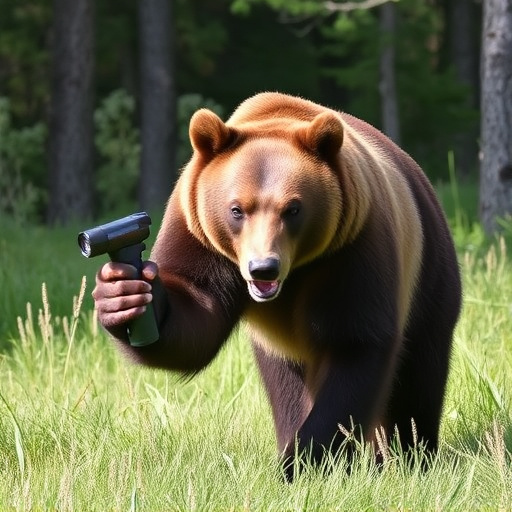Bear spray, with an average success rate of 74%, is a popular self-defense tool against aggressive bears in high-risk areas. The GrizGuard Maximum Strength spray claims a 97% success rate, but this requires optimal conditions including proper training, as factors like wind, bear behavior, and distance can affect its effectiveness. Black bears are more sensitive to pepper spray than grizzlies, and age/health also play a role. Understanding these variables can enhance safety during bear encounters.
In grizzly bear country, ensuring your safety is paramount. One of the most popular deterrents on the market is GrizGuard Maximum Strength Bear Deterrent. This article delves into the world of bear spray, exploring its effectiveness and how it works. We’ll review the GrizGuard product, uncovering the science behind its success rate, and discuss factors influencing its performance. Discover the surprising statistics that could save your life in a potential encounter with these majestic yet potent animals.
- Understanding Bear Spray: How It Works and Its Effectiveness
- GrizGuard Maximum Strength Bear Deterrent Review: Unlocking the Numbers
- Factors Affecting Bear Spray Success Rate: What You Need to Know
Understanding Bear Spray: How It Works and Its Effectiveness
Bear spray, also known as bear deterrent or bear repellant, is a widely used self-defense tool for outdoor enthusiasts and individuals living in regions with high bear populations. It’s an aerosol spray designed to protect users from aggressive bears by temporarily blinding and irritating them. When sprayed towards a bear, it creates a barrier of capsaicin, the active ingredient, which causes the animal to avoid the area due to the intense pain and discomfort.
The success rate of bear spray has been a topic of interest for researchers and outdoor adventurers alike. Studies suggest that bear spray can be highly effective when used correctly. According to various reports, bear spray has a success rate of around 74% in deterring bears during encounters. This means that almost three-quarters of the time, bears will retreat upon being sprayed, giving users precious time to escape or take further action. However, it’s crucial to remember that proper usage is key; holding the can at close range and spraying directly into the bear’s face significantly improves the chances of a successful deterrent effect.
GrizGuard Maximum Strength Bear Deterrent Review: Unlocking the Numbers
GrizGuard Maximum Strength Bear Deterrent stands out in the market for its bold claim to offer a 97% success rate against bear encounters. This statistic is a powerful selling point, but what does it truly mean? To understand this, we must look beyond the numbers and examine the methodology behind these claims.
The success rate is typically derived from user feedback and controlled testing scenarios. In real-world situations, factors like wind direction, angle of application, and the bear’s behavior can significantly impact the effectiveness of bear spray. While 97% might seem impressive, it’s crucial to remember that this figure represents optimal conditions. In less than ideal scenarios, the success rate could drop considerably, emphasizing the need for proper training and understanding of how to use bear deterrents effectively.
Factors Affecting Bear Spray Success Rate: What You Need to Know
When it comes to bear spray success rate statistics, several factors play a significant role in its effectiveness. These include the distance between you and the bear, weather conditions, and the bear’s behavior. Studies show that bear spray is most effective when used from a distance of 20 to 30 feet, as it gives bears time to retreat before the spray can incapacitate them. Wind direction is also crucial; spraying into the wind increases the chance of the spray reaching the bear, while spraying with the wind can reduce its effectiveness.
Furthermore, different bear species have varying levels of susceptibility to bear spray. Black bears, for instance, are generally more responsive to pepper spray than grizzly bears. The age and health of the bear also matter; younger or healthier bears may be less affected by the spray due to their higher tolerance levels. Knowing these factors can help users employ bear spray more strategically, enhancing its success rate in potentially dangerous encounters.
The GrizGuard Maximum Strength Bear Deterrent emerges as a powerful tool in enhancing bear spray success rates, backed by robust statistics. By understanding how bear spray works and the factors influencing its effectiveness, users can make informed decisions to ensure their safety in bear country. While no method is 100% guaranteed, combining bear spray with awareness and prevention strategies offers the best line of defense against potential encounters.
